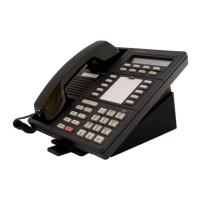MERLIN LEGEND Communications System Release 6.1
System Programming Guide
555-661-111
Issue 1
August 1998
Programming Procedures
Page 3-33System Renumbering
3
!
WARNING:
Use extreme caution when employing the
'HIDXOW1XPEHULQJ
option of
System Renumbering. Any numbering you have entered is erased and the
system numbering is set to factory settings.
NOTES:
1. The'HIDXOW1XPEHULQJoption of System Renumbering renumbers
local system extensions only. It also removes the local system’s
non-local dial plan entries.
2. Non-local dial plan ranges on local systems should be large enough to
minimize range renumbering when a remote system changes. When the
numbering of a remote system changes, the system manager should
check the new external numbers and ascertain their impact on the
non-local dial plan numbers accessed using this procedure, then make
changes manually.
Specifying New Extension Ranges 3
This procedure verifies that extension numbers on the local system do not conflict
with those on a non-local private network switch. For example, if Extension 110
exists in the local system, Extension 1100 cannot exist on a non-local system. It
also checks to see whether new extension number ranges conflict with existing
ranges set for the non-local system.
MERLIN LEGEND Communications System non-local dial plan numbering
supports extensions up to 4 digits in length (2-, 3-, or 4-digit dial plans), while
DEFINITY Communications Systems have 5-digit extension numbers. There are
two methods you can use to number DEFINITY non-local dial plan ranges.
Choose one of the following techniques, depending upon the actual extension
numbers you are entering in ranges and potential conflicts:
■ Specify ranges that include the first four digits in the extension numbers.
Each number you enter in the procedure represents 10 numbers in the
remote system. For example, an extension range entered as 4321 through
4322 represents remote extensions 43210 through 43220. Users actually
dial five digits. The local system recognizes the number range by the first
four digits. In Release 6.1 and later, program the number of dial digits to 5.
■ Enter the last four digits and use UDP routing to prepend the first digit in
the DEFINITY extension number. The local system recognizes the number
range using the last four digits. Users dial only the last four digits. This
method must be used for DID trunks that terminate on a MERLIN LEGEND
system which have numbers in the DID range that terminate on a
DEFINITY system. For details about UDP routing, see “Uniform Dial Plan
Routing” on page 3–565. In Release 6.1 and later, program the number of
dial digits to 4.
An extension range may stipulate a single extension number.

